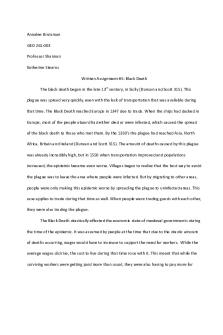GOE 261 Black Death Assignment #5 PDF

| Title | GOE 261 Black Death Assignment #5 |
|---|---|
| Author | Annalee Brutsman |
| Course | Disease Detectives: Epidemiology In Act |
| Institution | University of Kentucky |
| Pages | 3 |
| File Size | 46.2 KB |
| File Type | |
| Total Downloads | 116 |
| Total Views | 136 |
Summary
Download GOE 261 Black Death Assignment #5 PDF
Description
Annalee Brutsman GEO 261-003 Professor Shannon Katherine Stearns Written Assignment #5: Black Death The black death began in the late 13th century, in Sicily (Duncan and Scott 315). This plague was spread very quickly, even with the lack of transportation that was available during that time. The Black Death reached Europe in 1347 due to trade. When the ships had docked in Europe, most of the people aboard had either died or were infected, which caused the spread of the black death to those who met them. By the 1350’s the plague had reached Asia, North Africa, Britain and Ireland (Duncan and Scott 315). The amount of deaths caused by this plague was already incredibly high, but in 1550 when transportation improved and populations increased, the epidemic became even worse. Villages began to realize that the best way to avoid the plague was to leave the area where people were infected. But by migrating to other areas, people were only making this epidemic worse by spreading the plague to uninfected areas. This case applies to trade during that time as well. When people were trading goods with each other, they were also trading the plague. The Black Death drastically effected the economic state of medieval governments during the time of the epidemic. It was assumed by people at the time that due to the drastic amount of deaths occurring, wages would have to increase to support the need for workers. While the average wages did rise, the cost to live during that time rose with it. This meant that while the surviving workers were getting paid more than usual, they were also having to pay more for
food, housing, and land. This economic change led to feudal lords receiving larger profits from things such as grain prices, making feudalism thrive. The economy changed once again in 1375 when people had abnormally over-productive harvest, causing the price of crops to drop while the cost of labor remained the same. Surprisingly the black death led to commercialization of agriculture (Belich) due to how much it cost to fund labor. Eventually, the cost of labor and the wages that were “normal” before the Black Death, returned near the 17th century (Clark). This drastic change in the economy in the 13th century impacted today’s economy as well. Rising wages and the demand of labor led to the rise of capitalism, and the migration from small villages to cities. This migration caused a rise in many areas, such as industrialization, commercialization, and urbanization. Everyone wanted to find a way to make labor cheaper, while still creating the most product possible. This led to many new inventions and made people begin to think more about easier and more effective ways of producing goods, without having to increase wages.
Duncan,C.J. ,andS.Scot t ." Hi st or yofMedi ci ne. "WhatCausedt heBl ackDeat h?( 2005) : 31520.Www. post gr admedj . com.Web.18Feb.2017. . " Bl ackDeat h. "Hi st or y . com.A&ETel evi si onNet wor ks,2010.Web.18Feb.2017. . " Pl aguedbyDearLabour. "TheEconomi st .N. p. ,n. d.Web.18Feb.2017. . " TheHor r i f yi ngGl obalI mpactoft heBl ackDeat h. "About . com Educat i on.N. p. ,23May2014. Web.21Feb.2017.....
Similar Free PDFs

Black death and flagellants
- 5 Pages

The Black Death Portfolio
- 8 Pages

The Black Death
- 10 Pages

CHM 261, QUIZ 5
- 3 Pages

The Black Death Essay - Grade: A
- 4 Pages

Death penalty assignment
- 5 Pages

Physics 261 lab 2
- 11 Pages

Death and Dying 1-5
- 8 Pages

CHM 261, QUIZ 12
- 4 Pages

261 Study Guide Midterm
- 22 Pages

CHM 261, QUIZ 9
- 3 Pages

CHM 261, QUIZ 13
- 3 Pages

PLSC 261 Midterm
- 2 Pages

Folien 228-261
- 34 Pages
Popular Institutions
- Tinajero National High School - Annex
- Politeknik Caltex Riau
- Yokohama City University
- SGT University
- University of Al-Qadisiyah
- Divine Word College of Vigan
- Techniek College Rotterdam
- Universidade de Santiago
- Universiti Teknologi MARA Cawangan Johor Kampus Pasir Gudang
- Poltekkes Kemenkes Yogyakarta
- Baguio City National High School
- Colegio san marcos
- preparatoria uno
- Centro de Bachillerato Tecnológico Industrial y de Servicios No. 107
- Dalian Maritime University
- Quang Trung Secondary School
- Colegio Tecnológico en Informática
- Corporación Regional de Educación Superior
- Grupo CEDVA
- Dar Al Uloom University
- Centro de Estudios Preuniversitarios de la Universidad Nacional de Ingeniería
- 上智大学
- Aakash International School, Nuna Majara
- San Felipe Neri Catholic School
- Kang Chiao International School - New Taipei City
- Misamis Occidental National High School
- Institución Educativa Escuela Normal Juan Ladrilleros
- Kolehiyo ng Pantukan
- Batanes State College
- Instituto Continental
- Sekolah Menengah Kejuruan Kesehatan Kaltara (Tarakan)
- Colegio de La Inmaculada Concepcion - Cebu

